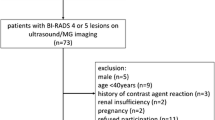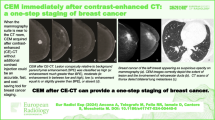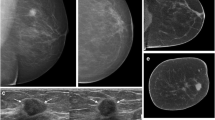Abstract
Purpose
To evaluate the detectability of breast cancer and visibility of the tumor extent using 70-kV single-energy contrast-enhanced (CE) breast computed tomography (70-kV CECT) compared with CE breast magnetic resonance imaging (CEMR).
Methods
Between 2013 and 2015, 110 patients with 112 breast cancer lesions who underwent breast surgery after undergoing both 70-kV CECT and CEMR were enrolled. The major axis lengths of the breast lesion were measured and compared with the pathologically determined major axes. Agreement in the measured major axes was evaluated using the intra-class correlation coefficient (ICC).
Results
Both 70-kV CECT and CEMR depicted all breast cancer lesions. The mean major axis was 3.0 (95% confidence interval [CI], 2.5–3.4) cm on CECT and 2.9 (2.6–3.3) cm on CEMR. The mean differences between the pathologically and radiologically measured major axes on 70-kV CECT and CEMR were 0.9 (0.7–1.1) and 1.0 (0.8–1.2) cm, respectively. The accuracy of the radiological major axes compared with the pathological major axes was 82.1% and 80.4% on CECT and CEMR, respectively (p = 0.81). The major axes on the two modalities demonstrated moderate agreement (ICC = 0.69, 95% CI 0.58–0.77). Pathologically and radiologically measured major axes on 70-kV CECT and CEMR demonstrated excellent agreement (ICC = 0.91, 95% CI 0.93–0.96).
Conclusions
Low-tube voltage (70-kV) CECT is the preferred modality to identify breast cancer lesions and tumor extent for preoperative planning because it has a similar diagnostic ability to CEMR and can be performed in the supine position.


Similar content being viewed by others
References
Shibamoto Y, Murai T, Suzuki K, Hashizume C, Ohta K, Yamada Y et al (2018) Definitive radiotherapy with SBRT or IMRT boost for breast cancer: excellent local control and cosmetic outcome. Technol Cancer Res Treat. https://doi.org/10.1177/1533033818799355
Shimauchi A, Yamada T, Sato A, Takase K, Usami S, Ishida T et al (2006) Comparison of MDCT and MRI for evaluating the intraductal component of breast cancer. AJR Am J Roentgenol 187:322–329
Uematsu T, Yuen S, Kasami M, Uchida Y (2008) Comparison of magnetic resonance imaging, multidetector row computed tomography, ultrasonography, and mammography for tumor extension of breast cancer. Breast Cancer Res Treat 112:461–474
Uematsu T (2010) Comparison of magnetic resonance imaging and multidetector computed tomography for evaluating intraductal tumor extension of breast cancer. Jpn J Radiol 28:563–570
Tozaki M, Kuroki Y, Kikuchi M, Kojima Y, Kubota K, Nakahara H et al (2016) The Japanese Breast Cancer Society clinical practice guidelines for screening and imaging diagnosis of breast cancer, 2015 edition. Breast Cancer 23:357–366
Uematsu T, Nakashima K, Kikuchi M, Kubota K, Suzuki A, Nakano S et al (2020) The Japanese Breast Cancer Society clinical practice guidelines for breast cancer screening and diagnosis, 2018 edition. Breast Cancer 27:17–24
Nakayama Y, Awai K, Funama Y, Liu D, Nakaura T, Tamura Y et al (2006) Lower tube voltage reduces contrast material and radiation doses on 16-MDCT aortography. AJR Am J Roentgenol 187:W490–W497
Okada K, Matsuda M, Tsuda T, Kido T, Murata A, Nishiyama H et al (2020) Dual-energy computed tomography for evaluation of breast cancer: value of virtual monoenergetic images reconstructed with a noise-reduced monoenergetic reconstruction algorithm. Jpn J Radiol 38:154–164
Volterrani L, Gentili F, Fausto A, Pelini V, Megha T, Sardanelli F et al (2020) Dual-energy CT for locoregional staging of breast cancer: preliminary results. AJR Am J Roentgenol 214:707–714
Marin D, Nelson RC, Samei E, Paulson EK, Ho LM, Boll DT et al (2009) Hypervascular liver tumors: low tube voltage, high tube current multidetector CT during late hepatic arterial phase for detection–initial clinical experience. Radiology 251:771–779
Nakagawa M, Ozawa Y, Sakurai K, Shimohira M, Ohashi K, Asano M et al (2015) Image quality at low tube voltage (70 kV) and sinogram-affirmed iterative reconstruction for computed tomography in infants with congenital heart disease. Pediatr Radiol 45:1472–1479
Kanda Y (2013) Investigation of the freely available easy-to-use software 'EZR' for medical statistics. Bone Marrow Transplant 48:452–458
Urano M, Shiraki N, Kawai T, Goto T, Endo Y, Yoshimoto N et al (2016) Digital mammography versus digital breast tomosynthesis for detection of breast cancer in the intraoperative specimen during breast-conserving surgery. Breast Cancer 23:706–711
Urano M, Shiraki N, Hara M, Toyama T, Shibamoto Y (2016) Multi-detector row CT-guided marking technique for breast-conserving therapy of early breast cancer: margin positivity and local control rates. Breast Cancer 23:252–260
Morris EA, Comstock CE, Lee CH et al (2013) magnetic resonance imaging. In: D'Orsi CJ (ed) ACR BI-RADS® Atlas, breast imaging reporting and data system. American College of Radiology, Reston, VA
King V, Gu Y, Kaplan JB, Brooks JD, Pike MC, Morris EA (2012) Impact of menopausal status on background parenchymal enhancement and fibroglandular tissue on breast MRI. Eur Radiol 22:2641–2647
Kamitani T, Yabuuchi H, Kanemaki Y, Tozaki M, Sonomura T, Mizukoshi W et al (2019) Effects of menstrual cycle on background parenchymal enhancement and detectability of breast cancer on dynamic contrast-enhanced breast MRI: a multicenter study of an Asian population. Eur J Radiol 110:130–135
Ogawa M, Nakagawa M, Arai N, Kan H, Ohba S, Shibata S et al (2019) Evaluation of thin-slice coronal single-shot turbo spin-echo diffusion-weighted imaging of the hand: a comparison with conventional echo-planar diffusion-weighted imaging. Magn Reson Med Sci. https://doi.org/10.2463/mrms.tn-2019-0115
Ahn SJ, Kim YS, Kim EY, Park HK, Cho EK, Kim YK et al (2013) The value of chest CT for prediction of breast tumor size: comparison with pathology measurement. World J Surg Oncol 11:130. https://doi.org/10.1186/1477-7819-11-130
Meinel FG, Canstein C, Schoepf UJ, Sedlmaier M, Schmidt B, Harris BS et al (2014) Image quality and radiation dose of low tube voltage 3rd generation dual-source coronary CT angiography in obese patients: a phantom study. Eur Radiol 24:1643–1650
Yu L, Christner JA, Leng S, Wang J, Fletcher JG, McCollough CH (2011) Virtual monochromatic imaging in dual-source dual-energy CT: radiation dose and image quality. Med Phys 38:6371–6379
Prionas ND, Lindfors KK, Ray S, Huang SY, Beckett LA, Monsky WL et al (2010) Contrast-enhanced dedicated breast CT: initial clinical experience. Radiology 256:714–723
Carbonaro LA, Tannaphai P, Trimboli RM, Verardi N, Fedeli MP, Sardanelli F (2012) Contrast enhanced breast MRI: spatial displacement from prone to supine patient's position. Preliminary results. Eur J Radiol 81:e771–774
Telegrafo M, Rella L, Stabile Ianora AA, Angelelli G, Moschetta M (2016) Supine breast US: how to correlate breast lesions from prone MRI. Br J Radiol 89:20150497. https://doi.org/10.1259/bjr.20150497
Joukainen S, Masarwah A, Könönen M, Husso M, Sutela A, Kärjä V et al (2019) Feasibility of mapping breast cancer with supine breast MRI in patients scheduled for oncoplastic surgery. Eur Radiol 29:1435–1443
Perrone A, Lo Mele L, Sassi S, Marini M, Testaverde L, Izzo L (2008) MDCT of the breast. AJR Am J Roentgenol 190:1644–1651
Calabrese EJ (2019) The linear no-threshold (LNT) dose response model: a comprehensive assessment of its historical and scientific foundations. Chem Biol Interact 301:6–25
Shibamoto Y, Nakamura H (2018) Overview of biological, epidemiological, and clinical evidence of radiation hormesis. Int J Mol Sc 19:2387
Wang Z, Sugie C, Nakashima M, Kondo T, Iwata H, Tsuchiya T et al (2018) Changes in the proliferation rate, clonogenicity, and radiosensitivity of cultured cells during and after continuous low-dose-rate irradiation. Dose Response 17:1559325819842733
Söderberg M, Gunnarsson M (2010) The effect of different adaptation strengths on image quality and radiation dose using siemens care dose 4D. Radiat Prot Dosimetry 139:173–179
Author information
Authors and Affiliations
Corresponding author
Ethics declarations
Conflict of interest
The authors declare that they have no conflicts of interest.
Ethical approval
All procedures performed in studies involving human participants were in accordance with the ethical standards of our institutional review board and with the 1964 Helsinki declaration and its later amendments or comparable ethical standards.
Informed consent
The requirement for informed consent was waived for this retrospective study, but written informed consent for each examination and possible use of the data for research purposes was received from all patients.
Additional information
Publisher's Note
Springer Nature remains neutral with regard to jurisdictional claims in published maps and institutional affiliations.
Rights and permissions
About this article
Cite this article
Hisoshima, M., Urano, M., Ohashi, K. et al. Utility of 70-kV single-energy CT in depicting the extent of breast cancer for preoperative planning. Breast Cancer Res Treat 184, 817–823 (2020). https://doi.org/10.1007/s10549-020-05909-7
Received:
Accepted:
Published:
Issue Date:
DOI: https://doi.org/10.1007/s10549-020-05909-7




